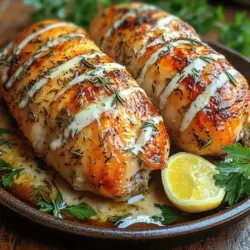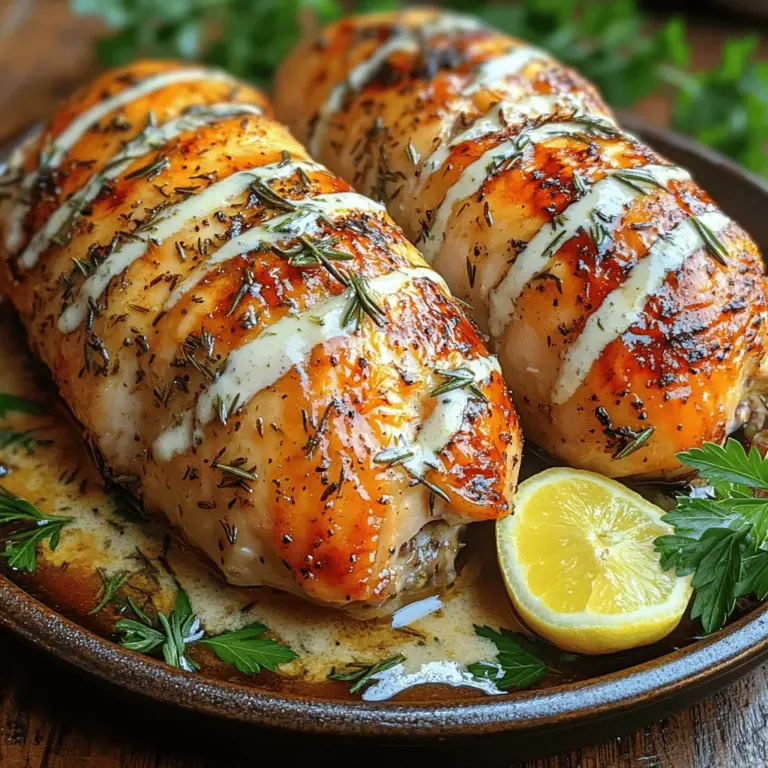Introduction
Roasted chicken has long been a staple in households around the world, celebrated for its comforting flavors and versatility. This dish serves as a canvas, allowing cooks to experiment with a variety of seasonings, marinades, and accompaniments. Whether it’s a casual weeknight dinner or a festive gathering, roasted chicken never fails to impress. Today, we are elevating this classic dish with a delightful twist: Herb Roasted Chicken in a creamy white sauce. This recipe highlights the succulent flavors of the chicken, enhanced by a rich and savory sauce that perfectly marries the herbs and spices.
What makes this recipe particularly appealing is its simplicity. With just a handful of ingredients and straightforward steps, you can create a dish that looks and tastes gourmet. The creamy white sauce takes this herb roasted chicken to another level, offering a luxurious texture that complements the crispy, golden skin of the chicken. Whether you’re hosting a dinner party or simply looking to impress your family with a home-cooked meal, this recipe is sure to become a favorite.
Understanding the Ingredients
To achieve the perfect herb roasted chicken in creamy white sauce, understanding the key ingredients is essential. Let’s take a closer look at what you’ll need for this mouthwatering dish.
Whole Chicken
Using a whole chicken is not only economical but also provides a richer flavor compared to using chicken parts. The bones and skin contribute to the depth of flavor during the roasting process, resulting in a juicier and more tender meat. When you roast a whole chicken, you also have the added benefit of serving a stunning centerpiece at the dinner table. Plus, the leftovers can be repurposed for sandwiches, salads, or soups, making it a versatile choice that extends beyond the initial meal.
Olive Oil
Fat plays a crucial role in cooking, helping to enhance flavors and achieve that coveted golden-brown crust. Olive oil is an excellent choice for this recipe, as it not only adds richness but also offers health benefits, including heart-healthy monounsaturated fats and antioxidants. By coating the chicken in olive oil, you ensure that the herbs and spices adhere better, creating a flavorful crust that seals in moisture during roasting.
Fresh Herbs
Herbs are the soul of this herb roasted chicken recipe. Fresh rosemary and thyme are particularly chosen for their aromatic qualities and ability to infuse flavor into the meat. Rosemary imparts a woodsy and slightly piney flavor, while thyme adds an earthy, subtle sweetness. Together, they create a harmonious blend that elevates the dish, making each bite bursting with freshness.
Lemon
Lemon is an essential ingredient that balances flavors beautifully. The acidity of the lemon brightens the dish, cutting through the richness of the chicken and creamy sauce. Squeezing lemon juice over the chicken before roasting not only enhances the flavor but also helps to tenderize the meat. Furthermore, placing lemon halves inside the cavity of the chicken adds an aromatic essence during the cooking process, enriching the overall flavor.
Heavy Cream and Dijon Mustard
The creamy white sauce is where the magic happens. Heavy cream brings a luscious texture that coats the chicken and adds a luxurious element to the dish. When combined with Dijon mustard, the sauce gains a subtle tang and depth of flavor. The mustard serves as a perfect counterpoint to the richness of the cream, creating a balanced sauce that enhances the herb roasted chicken without overpowering it.
Preparation Steps for Perfect Herb Roasted Chicken
Now that we’ve covered the essential ingredients, let’s dive into the preparation steps that will ensure your herb roasted chicken turns out perfectly every time.
Preheating the Oven
The first step in any roasting endeavor is preheating your oven. This is a critical stage for achieving even cooking and a crispy skin. Preheat your oven to 425°F (220°C). A high temperature is essential for roasting a whole chicken, as it helps render the fat from the skin and creates that desirable golden crust. While the oven is heating, you can focus on preparing the chicken.
Preparing the Chicken
Before you start seasoning, it’s important to properly prepare the chicken. Begin by rinsing the chicken under cold water to remove any residual blood or impurities. After rinsing, pat the chicken dry with paper towels. This step is crucial; excess moisture on the skin can prevent it from crisping up during roasting.
Next, prepare your roasting pan. Choose a sturdy roasting pan that can accommodate the whole chicken comfortably. A pan with a rack is ideal, as it allows air to circulate around the chicken, promoting even cooking. If you don’t have a rack, you can create one using vegetables like carrots and onions, which will also add flavor to the drippings.
Seasoning the Chicken
The next step is to infuse the chicken with flavor. In a small bowl, combine olive oil with chopped fresh rosemary and thyme. This herb-infused oil will serve as a delicious marinade and seasoning for the chicken.
To maximize flavor penetration, carefully loosen the skin of the chicken with your fingers. Gently rub the herb-infused oil mixture under the skin, making sure to cover as much of the meat as possible. This technique allows the flavors to meld with the meat during roasting, ensuring that every bite is packed with deliciousness.
Infusing Flavor with Lemon
To further enhance the flavor profile of your herb roasted chicken, it’s essential to incorporate lemon. Squeeze the juice of half a lemon over the chicken, allowing it to soak into the meat. This adds brightness and acidity, balancing the richness of the dish.
Next, take the remaining lemon halves and place them inside the cavity of the chicken. This will infuse the meat with a delightful lemon aroma as it roasts. Additionally, the steam generated from the lemon will help keep the chicken moist during the cooking process.
By following these initial steps, you are setting the stage for a flavorful and succulent herb roasted chicken. The combination of fresh herbs, zesty lemon, and the careful preparation of the chicken will ensure that your dish is not only delicious but also visually stunning when served.
Stay tuned for the next part of the article, where we will delve into the roasting process and the creation of the creamy white sauce that will elevate this dish to new heights.
{{image_2}}
Roasting Technique for Juicy Chicken
Roasting a chicken is an art that balances time, temperature, and technique to achieve a perfectly juicy and flavorful dish. The process of roasting not only cooks the chicken but also enhances its natural flavors, elevating a simple meal into a delightful feast.
Overview of the Roasting Process
To begin with, the key to roasting a succulent chicken lies in the preparation and understanding of the roasting process itself. First, ensure your chicken is completely thawed and at room temperature before roasting. This step is crucial as it allows for even cooking. Preheat your oven to 375°F (190°C), as this temperature is ideal for roasting chicken, allowing the skin to crisp while keeping the meat tender.
Pouring Chicken Broth
One of the secrets to achieving moist and flavorful chicken lies in the addition of chicken broth. Before placing the chicken in the oven, pour about one cup of low-sodium chicken broth into the roasting pan. This broth creates steam while the chicken roasts, infusing moisture and flavor throughout the meat. The broth also serves as a base for the creamy white sauce that will accompany your chicken, tying the dish together beautifully.
Cooking Time and Temperature
When it comes to roasting chicken, cooking time and internal temperature are paramount. The general rule of thumb is to roast your chicken for approximately 20 minutes per pound. However, more important than timing is the internal temperature. Use a meat thermometer to check the thickest part of the chicken thigh, ensuring it reaches an internal temperature of 165°F (74°C) for safe consumption. This guarantees that the chicken is fully cooked and safe to eat, while still being juicy and flavorful.
Basting
Basting is a technique often overlooked, yet it plays a significant role in ensuring a juicy outcome. Every 30 minutes, open the oven and use a baster or a spoon to drizzle the pan juices over the chicken. This not only keeps the skin moist but also enhances the depth of flavor in the chicken. The fat from the skin combined with the chicken broth creates a luscious glaze that will make your roasted chicken irresistible.
Crafting the Creamy White Sauce
While your chicken is roasting, it’s the perfect time to whip up a creamy white sauce. This sauce will complement the savory flavors of your herb-roasted chicken, adding a rich, velvety texture to your dish.
Step-by-Step Instructions for Making the Sauce
1. Gather Your Ingredients: You will need butter, minced garlic, flour, heavy cream, chicken broth (from the roasting pan), and your choice of herbs (thyme, parsley, or rosemary work well).
2. Melt the Butter: In a saucepan over medium heat, melt 2 tablespoons of butter. Allow it to foam slightly, which indicates it’s hot enough to start cooking.
3. Add Garlic: Stir in 2 cloves of minced garlic and sauté for about 30 seconds until fragrant, being careful not to burn it.
4. Create a Roux: Sprinkle in 2 tablespoons of flour, stirring constantly to combine with the butter and garlic. Cook this mixture for about 2 minutes until it turns a light golden color, which indicates that the flour has cooked through.
5. Incorporate the Cream: Gradually whisk in 1 cup of heavy cream, followed by 1 cup of the chicken broth from the roasting pan. This combination will create a luxurious sauce.
6. Thicken the Sauce: Continue to stir the mixture over medium heat until it thickens, which usually takes about 5-7 minutes. Remember to keep stirring to prevent the sauce from sticking to the pan.
Adjusting Flavors
Once your sauce has thickened, it’s time to adjust the flavors. Taste the sauce and add salt and pepper to your liking. You can also incorporate additional herbs or a squeeze of lemon juice to brighten the flavors. If you prefer a more robust flavor, consider adding a splash of white wine or Dijon mustard.
Resting the Chicken: A Crucial Step
After the chicken has reached the proper internal temperature, it’s essential to allow it to rest before carving. This step is often overlooked but is crucial for achieving the best texture and juiciness.
Importance of Allowing the Chicken to Rest
Resting allows the juices within the chicken to redistribute throughout the meat. If you carve the chicken immediately after removing it from the oven, you risk losing those precious juices, resulting in dry meat. Aim to let your chicken rest for at least 15-20 minutes, covered loosely with aluminum foil. This simple step will greatly enhance the overall eating experience.
Serving Suggestions and Presentation
Once your chicken has rested, it’s time to carve and serve. How you present your dish can elevate it even further, making it visually appealing and enticing.
Carving the Chicken
To carve the chicken, start by removing the legs. Use a sharp knife to cut through the skin connecting the legs to the body, and then gently pull the leg away from the body to expose the joint. Cut through the joint to remove the leg completely. Next, remove the wings by using the same method. Finally, slice the breast meat, cutting against the grain for maximum tenderness.
Presentation Tips for an Appealing Dish
For an impressive presentation, arrange the carved chicken on a large serving platter. Drizzle the creamy white sauce generously over the pieces, allowing it to pool slightly on the platter. This not only adds visual appeal but also lets guests enjoy the sauce with each bite.
Suggestions for Garnishing
For a finishing touch, garnish your dish with freshly chopped parsley or thyme. This not only adds color but also enhances the aroma and flavor profile. Serve the roasted chicken alongside seasonal vegetables or a fresh salad for a complete meal.
Pairing Ideas
To complement the herb-roasted chicken in creamy white sauce, consider serving side dishes that balance the richness of the sauce. Garlic mashed potatoes, roasted asparagus, or a light couscous salad make excellent accompaniments. A crisp green salad with a tangy vinaigrette can also provide a refreshing contrast to the creamy sauce.
Nutritional Overview
Understanding the nutritional elements of your dish is essential, especially if you aim for a balanced diet. Herb-roasted chicken in creamy white sauce provides a substantial source of protein, which is vital for muscle repair and growth. The use of fresh herbs not only enhances flavor but also offers various health benefits, including antioxidants and anti-inflammatory properties.
Breakdown of Nutritional Elements
– Chicken: A lean source of protein, providing essential amino acids and B vitamins.
– Cream: While rich in calories, heavy cream offers calcium and vitamin D, which are beneficial for bone health. Using it in moderation can enhance the dish without overwhelming your diet.
– Garlic: Known for its immune-boosting properties, garlic also contributes to heart health.
– Herbs: Fresh herbs like thyme and parsley are low in calories and packed with vitamins and minerals.
Conclusion
In summary, this herb-roasted chicken in creamy white sauce is not only a simple recipe but also a guaranteed crowd-pleaser that can elevate any meal occasion. With its succulent, juicy chicken enveloped in a rich, creamy sauce, this dish is perfect for family dinners, gatherings, or even a cozy weeknight meal. The combination of roasting techniques, a flavorful sauce, and thoughtful presentation makes this recipe a favorite that will surely impress your guests and create lasting memories around the dinner table. Enjoy the process of cooking, and savor the delightful flavors of your homemade herb-roasted chicken!


